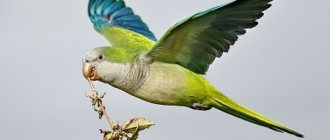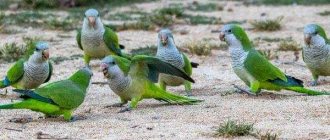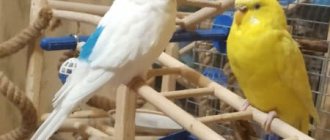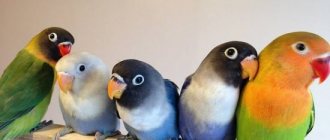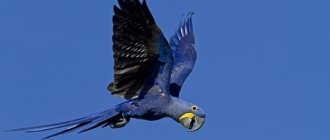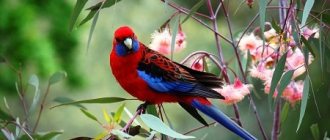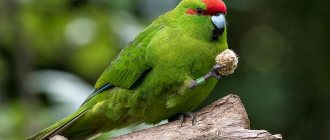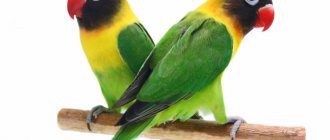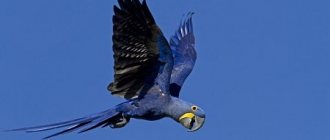Appearance
The appearance of the parrot, which is also called kalita, is typical of medium-sized tropical birds. The birds grow up to 30-35 cm in length, including the tail, which, like other representatives of the species, makes up almost half of the total size. The peculiar sexual dimorphism is interesting: the females of this species are larger than the males. Other characteristics include:
- weight - from 90 to 150 g;
- color in nature: greenish, bluish, yellowish;
- color of birds raised in captivity: bright orange, blue, red-yellow;
- beak: brown, medium power.
Characteristic feature: gray belly and head, which is why the birds received the nickname monks or Quaker parrots. Wild representatives of the species are relatively dull; they have a camouflage green color, which helps them hide from predators in the foliage. Those bred in captivity are more colorful and have interesting colors.
Features of Quakers
Quakers have one interesting feature: they are the only parrots that build nests. While other species live in hollow trees, our heroes spend a lot of time creating elaborate homes from branches and other plant material.
Their homes are similar to communal apartments: there may be separate “rooms” with separate entrances for each pair of birds. In total, 20-30 couples can live in a “communal apartment”. Quaker "houses" are sometimes the size of a car and weigh 200 pounds or more. Nests are built not only in trees, but also on power line supports. The exception is the rock species, which nest in rock crevices.
In some places, especially in the southern states, wild Quaker colonies pose a threat to crops and native bird species. In some states, it is illegal to keep these birds in your home.
Where does he live?
Unlike many other exotic birds, Quaker parrots are not in danger of extinction. This is a common species of birds, which in their natural habitat can even be considered pests, because they fly into gardens and fields and spoil the harvest. Birds love warm climates, dense forests with an abundance of vegetation, where they can hide from enemies, build nests and where there is enough food.
The largest number of monk parrots is in Barcelona: they are as common there as our ordinary rock pigeons or sparrows. Brazil, Uruguay, Argentina are all natural habitats for birds. They are found in forests in large flocks, but often fly to cities, where there is a lot of tasty and affordable food, and there are much fewer predators.
Description of the gate
This type of parrot also has another name - monk kalita. It is small in size: length is 25–30 cm, and weight is 100–140 grams. The color scheme of the coat differs from other birds. The appearance is dim, with a predominance of green color. The tail, wings and back are grassy in color. The grayish cheeks and forehead form a hood, like a priest's. There are other varieties of parrot colors obtained through selective breeding. The wingspan reaches 40 cm. The bird's lifespan is about 30 years.
You can determine the sex of a parrot in different ways:
- Conducting DNA analysis;
- use of surgical method;
- assessment of bird behavior during the nesting period.
The color of the female is no different from the male. Therefore, during nesting, sex can be determined by characteristic behavior. The female is engaged in internal work: she builds a bedding from grass and twigs. The male works outside, he drags large branches to the nest.
Nutrition
In nature, Kalita parrots feed on everything they can find in forests, fields and cities. The basis of the diet is grains of any origin, both seeds of wild plants and cultivated plantings. They like to fly to fields in large flocks and consume grain, for which they are persecuted in places of active breeding. The diet also includes:
- Insects and insect larvae are the main source of animal protein needed by many birds, small numbers of Quaker parrots are beneficial to fields and gardens as they control pests.
- Fruits, especially sweet ones - this feature of the diet is typical for absolutely all types of parrots, monks are no exception. They feed on pulp and juice.
- Nuts and oilseeds are very popular and serve as a source of fat and calories, but it is recommended to limit them at home, because if there is a lack of exercise, birds are prone to gaining excess weight.
- Flowers, herbs, vegetables are a source of vitamins and minerals.
Wild birds living in cities have adapted to asking for treats from people walking in parks; they do not hesitate to dig through the garbage and pick up scraps. However, such a diet cannot be called healthy; parrots from the nursery are fed a specially compiled menu with a harmonious distribution of microelements and nutrients.
Maintenance and care at home
Despite the fact that Quakers were brought to Europe almost 200 years ago, they are not in great demand. The reason is a loud cry, which not everyone likes. Otherwise, these cute parrots are suitable for home keeping - they are friendly, unpretentious, active, and can be trained quickly.
Those who decide to get monk parrots should remember the following recommendations for their maintenance and care:
- Providing regular sunlight (in winter - additional artificial lighting).
- Maintaining normal microclimate indicators: - permissible temperature range 18-20°C; - recommended humidity - 60-75%.
- Eliminating possible stress for the bird.
- Arrangement of the cage, timely cleaning of it.
- Diet control.
- Spending time with your pet every day.
- Timely trimming of claws.
The monk parrot is a lover of gnawing everything in its path. In order to prevent damage, it is recommended to distract the bird with toys when walking.
How to arrange a cage
The requirements for Quaker housing are as follows:
- Recommended dimensions: from 90x50x70 cm.
- The main material of the cage is dense metal rods.
- The shape of the house is rectangular or square.
- Tall tray with sand.
- Availability of equipment (feeders, drinking bowls, perches, bathtub) and playgrounds.
- Installing a strong deadbolt lock.
- Once a month it is recommended to carry out a general cleaning of the cage, and once a quarter - to disinfect it along with the equipment.
What to feed
Monks are quite picky when it comes to food. Their diet should include:
- Grain and grain mixtures.
- Fruits, berries, vegetables, seeds, herbs.
- Flowers, buds.
- Insects with larvae.
- Tree branches.
- Chalk, shell rock, cuttlefish shell, sand.
- Vitamin and mineral supplements.
The favorite treat of Kalita parrots is apples.
Character and behavior, ability to speak
Quakers are distinguished by their cheerful disposition, sociability, and intellectual abilities. They get along well and play with other poultry. When communicating with birds, it is necessary to use an arsenal of bird toys. When it comes to conversation, these parrots have no equal. The monks are very talkative. They are easy to train. With daily training, in just a few months they are already chatting quite well with their owner - they chirp very interestingly with a peculiar clicking sound.
Monk parrots partially understand the essence of the words spoken (they can call a specific person by name, announce their need for something). But music for Quakers is pure pleasure. They not only sing along and dance to the beat, but also compose their own “masterpieces” from excerpts of what they hear. The hoarse voice, or rather the loud, creaky cry of birds, is not to everyone’s liking, but it is thanks to it that they stand out noticeably against the background of their relatives.
Monks are distinguished by some behavioral characteristics:
- They like to soak everything in water.
- They love to steal and hide small objects they like (buttons, pencils, pieces of paper). To avoid incidents, it is better to remove everything valuable from the birds’ field of view.
Aggressiveness in birds only manifests itself when there is an encroachment on their “property” (cage, toys and other objects to which the Quakers are already accustomed and which they have accepted as “property”).
Emotional irritation, apathy and self-plucking can occur with insufficient attention from a person, as well as with frequent changes of owner.
Taming
Only proper education and constant training can calm down a noisy Monk at home. After acquisition, the parrot is given the opportunity to adapt for some time (about 2-3 weeks). When the bird gets used to it, they begin to study.
Aspects of training:
- Gradual adaptation to the owner's hands.
- Constant conversations with the bird.
- Daily walking (flights around the apartment).
- Using a variety of toys (balls, ropes, strings, cups) during games.
- Reward all workouts with treats.
Video Parrot Kalita Monk Quaker choice, taming
Reproduction in captivity
In the natural environment, Quaker people remove them from the nest while they are still chicks, and then feed them in nurseries. This technique makes it possible to eliminate discomfort when communicating with a person in the future and to accustom him to home feeding. And already grown parrots, acclimatized to being kept in a cage, are sold to everyone.
But monk parrots are also able to reproduce in captivity if they are provided with comfortable living conditions. Ornithologists put forward a number of requirements when breeding this species:
- The presence of a spacious cage or enclosure in which the couple is placed during the mating season.
- Arrangement of the base of the nest on a hill, which, after mating, the birds improve to the desired condition.
- Minimal human intervention during bird reproduction.
- Grown-up offspring are removed from their parents after 3 weeks of age and fed separately.
Video I bought the third monk
Reproduction
Quaker parrots are small birds that are vulnerable to predators, so in nature they prefer the strategy of “hiding high and in as dense foliage as possible.” Characteristic feature: they build nests very high: those that live in forests - on the tops of trees, urban ones - on telegraph poles, on the roofs of high-rise buildings.
Breeding monk parakeets in captivity is quite an easy task. They reproduce well in spacious cages and with good care. The female brings from 4 to 8 eggs; in the wild, 2-4 chicks survive from the clutch, but in captivity there are no problems with preserving the entire litter. Hatching lasts 23-27 days.
Reproduction of monk parrots or what kind of parents are they?
The arrangement of the nest follows a strict division: the males are entrusted with decorating the outer part, the chores of interior decoration fall on the female, who does it very carefully and responsibly.
After mating, the expectant mother lays 4-6 eggs, and after three and a half weeks the babies hatch. Only by the middle of the second month do they begin to leave the parental nest, but for another couple of weeks their parents do not take their eyes off them, feeding and protecting them.
In good hands, parrots can live for three decades and bear offspring twice a year. Due to the fact that Kalitas are very good parents and naturally hardy, their chicks in captivity have almost 100% survival rate.
Nesting
Quakers build large nests on the principle of “communal apartments”: up to twenty to thirty pairs live in one place. Massive structures can be quite noticeable, but they are made from twigs and leaves in such a way that they blend as much as possible with the trunk and branches of the tree. Much more noticeable are the kalyta dwellings built in cities.
During the mating season, males begin building nests. Parrots rarely separate and remain within the same flock, although they prefer one partner throughout their lives. Males are engaged in the construction of nests, they also protect their “consorts” while they sit on the eggs and are simultaneously engaged in obtaining food. The “team” allows you to fly off to fish alone; someone always remains to “guard” the nest. The chicks hatch naked and helpless, but at 6-8 weeks they are ready for independent life. Little Quakers either join the flock or leave it.
How to choose the right one and how much does a parrot cost?
To make it easier to choose an exotic bird, it is recommended to seek help from an ornithologist in advance. It will help determine the most active and healthy pet. The most important criterion for choosing a parrot is its age. It is most difficult for adults to get used to a new place. They may show aggression towards their new owner. It is recommended to buy a chick no older than two months. When choosing a parrot, you should pay attention to external characteristics. A bird sitting peacefully on a perch and spreading its wings is not the best option. She may have a serious illness that the future owner will have to deal with.
It is necessary to inspect the area near the bird's anus: there should be no unpleasant odor or pieces of excrement. Their presence indicates intestinal disease. Kalita's obvious thinness is a sign of malnutrition. It may be associated with problems in the development of the bird's body.
Before purchasing, you should find out the cost of an exotic bird in advance. The price of Quaker parrots depends on many factors. It is influenced by the conditions in which the bird was kept, appearance and genetic predisposition to diseases. You can buy a monk at the nursery for 7,000 rubles. If you have accompanying documents, the cost is much higher. On the illegal market, the price of a monk parrot varies greatly. When purchasing poultry in such places, you need to be prepared for serious problems. She may have mental disorders due to the terrible conditions of her detention.
Home maintenance
Kalita is considered one of the best pets. These are smart, very talkative and easy to train parrots. They are extremely sociable, easily adopting human speech, as well as any other sounds. The monk parrot speaks well and remembers entire phrases. Other advantages and features of home maintenance:
The disadvantages of Kalita as a pet are a continuation of the advantages. These are noisy birds that require a lot of attention, otherwise they get bored and may even get sick. In addition, they are noisy and make a lot of sounds, so it is not recommended for those who like quietly chirping birds to purchase a monk.
The ability to talk and the habits of a parrot
A Quaker parrot can clearly pronounce words it hears, reproduce simple melodies with its voice, and imitate domestic animals. You can’t expect an adequate “conversation” from them, but such abilities are enough to have an interesting time together.
Friendliness is another trait common to sociable monks. They treat well not only the owner, but also other household members and guests. Affectionate birds can interact fearlessly with cats, dogs and other pets.
Constant development is important for Kalita: daily games, training, and education are simply necessary. When a parrot walks, it should have the opportunity to sort through various trinkets, chew them, and pick them up with its paw. In addition to game items, you should offer him logical tasks. You won't be bored with such an active pet.
It’s interesting that Quakers sneak whatever they like into their hiding places. Just as the magpie brings shiny things to its nest, the monk parrot hides small objects somewhere in a secluded corner.
Breeding
Many breeders specifically breed parrots of this particular species. Birds willingly give birth to offspring in captivity, and usually live longer than in the wild - up to 30-40 years versus 15 without human attention. Another peculiarity is that wild monk parrots are green-gray in color, and breeders have managed to obtain many interesting colors. There are blue, orange, red-yellow and multi-colored parrots.
It is recommended to purchase chicks from nurseries where it is well known who their parents were and that the birds are healthy. Breeders offer a certificate of the parrot's breed, as well as a personal “passport” with vaccinations against major diseases. You should not buy a chick or an adult parrot at the market, since they most likely offer illegally smuggled wild specimens; they become much less accustomed to humans, are often affected by parasites and are simply sick or weak.
Parrot Kalita or what a real monk looks like
The monk parrot or Kalita cannot boast of gigantic size, such as a cockatoo. Its height almost never exceeds 30 cm including tail, and its weight is 150 grams. The bird's second nickname is Quaker. History is silent about what the bird has to do with the Quakers, representatives of one of the Christian Protestant movements. But there is an assumption that this is connected with one of the self-names of Quaker communities - Friends. Maybe this is how the parrot’s friendly disposition towards humans is emphasized? After all, birds of this species are actually very devoted and faithful friends.
But why they call him a monk is definitely known. It's all about the gray cap that covers the bird's head and is shaped very much like the headdress of church ministers.
The rest of the color of the parrot, although varied, like all exotic birds, does not have the same richness of colors as that of the Gray or Macaw.
- The back, tail and main part of the wings are green, blue, indigo, yellow or orange.
- The lower part of the wings may be a different shade, for example blue.
- The cheeks, throat, forehead and belly are usually light gray.
- The beak is small, straw-colored.
The bird's voice is loud and hoarse. Sometimes it can make sounds that are very unpleasant to human hearing. If a parrot gets bored, it can “delight” those around it for a long time with a deafening cacophony of a set of nasty squeaks.
